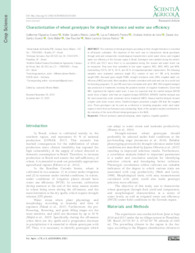Characterization of wheat genotypes for drought tolerance and water use efficiency.
Characterization of wheat genotypes for drought tolerance and water use efficiency.
Author(s): SOARES, G. F.; RIBEIRO JUNIOR, W. Q.; PEREIRA, L. F.; LIMA, C. A.; SOARES, D. dos S.; MULLER, O.; RASCHER, U.; RAMOS, M. L. G.
Summary: ABSTRACT: The selection of wheat genotypes according to their drought tolerance is essential to off-season cultivation. The objective of this work was to characterize wheat genotypes through yield and components, morphological characteristics under water stress, and irrigated water use efficiency in the Cerrado region in Brazil. Genotypes were planted during the winters of 2016 and 2017 since there is no precipitation during this season and water levels can be measured. They were then submitted to four water regimes: WR1, WR2, WR3, and WR4, representing 100 %, 83 %, 50 %, and 30 % of evapotranspiration replacement. The following variables were evaluated: peduncle length (PL), number of ears m?2 (NE m?2), hectoliter weight (HW), thousand grain weight (TGW), drought resistance index (DRI), irrigated water use efficiency (IWUE) and yield. Most variables showed correlation with yield and can be a useful tool for breeding programs. PL and HW were best correlated with yield. BRS 264 (irrigated biotype) was productive in treatments receiving the greatest number of irrigation treatments. Given that WR1 registered the highest water level, it was not expected that the rainfed biotype (BR18) would show a higher yield than an irrigated biotype (BRS254). BRS404 (rainfed biotype) was the most productive under moderate stress treatment (WR3). Aliança (rainfed biotype) showed a higher yield under severe stress. Rainfed biotypes presented a higher DRI than the irrigated ones. These genotypes can be used as a reference in breeding programs under each water regime in which their performance was outstanding. None of the variables studied contributed to the selection of the most efficient wheat genotypes in the IWUE
Publication year: 2021
Types of publication: Journal article
Unit: Embrapa Cerrados
Observation
Some of Embrapa's publications are published as ePub files. To read them, use or download one of the following free software options to your computer or mobile device. Android: Google Play Books; IOS: iBooks; Windows and Linux: Calibre.
Access other publications
Access the Agricultural Research Database (BDPA) to consult Embrapa's full library collection and records.
Visit Embrapa Bookstore to purchase books and other publications sold by Embrapa.

